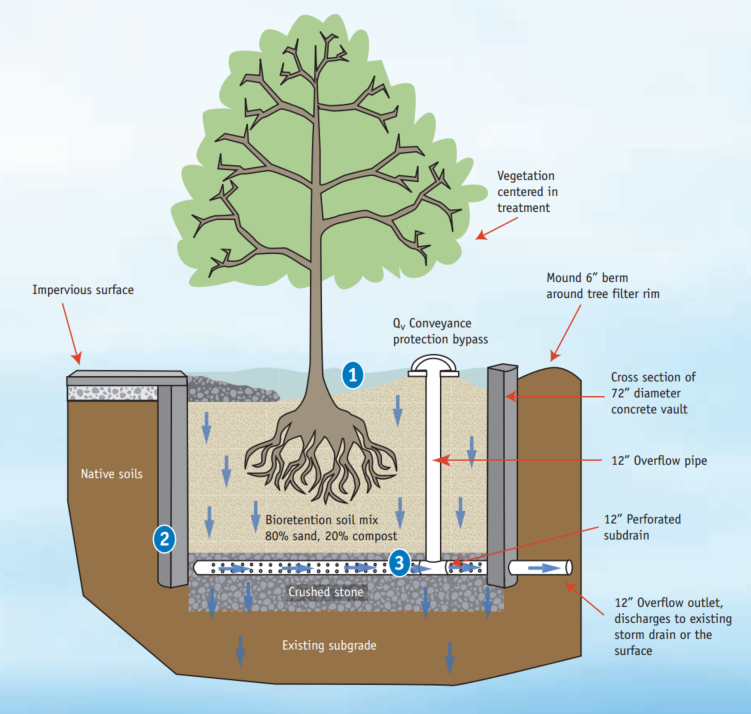TREE BOX FILTERS
(Adapted from Boston Water and Sewer Commission Stormwater BMP Fact Sheet)

Description
Tree box filters are a proprietary biotreatment device that is designed to mimic natural systems such as bioretention areas by incorporating plants, soil, and microbes. Tree box filters are installed at curb level and consist of an open bottom concrete barrel filled with a porous soil media, an underdrain in crushed gravel, and a tree. Tree box filters are highly adaptable solutions that can be used in all types of development and in all types of soils but are especially applicable to ultra-urban areas.
Applications
Commonly used in densely urbanized areas such as along roads, highways, sidewalks and parking lots.
Advantages
- Reduces volume and rate of runoff
- Smaller footprint required
- May be used as pretreatment device
- Provides decentralized stormwater treatment
- Ideal for redevelopment or in ultra-urban setting
Limitations
- Vegetative maintenance required
- Treats small volumes
- Treats small tributary areas
Ability to Meet Massachusetts Stormwater Standards
Presumed to remove 80% of Total Suspended Solids (Stormwater Management Standard #4).
General Cost Considerations
Estimated cost range of tree filters is $10,000 and $18,000.
Design Considerations
Note: for more detailed design guidance refer to the Massachusetts Stormwater Handbook
- Design at a minimum to capture and treat the required water quality volume
- Design to drain in less than 72 hours
- Tree box filters are typically designed in layers as follows (bottom to top):
- Line bottom of excavation with filter fabric
- Install precast concrete barrel (minimum 6 feet in diameter), approximately 4 feet deep
- Pack a perforated underdrain pipe in a clean, washed crushed stone layer (minimum 24-inch layer)
- Minimum 1 to 2 feet of soil media (or per manufacturer specification)
- Minimum 6 inches of ponding depth
- Design an overflow riser pipe with grate, connected to perforated underdrain
- Design curb cut to act as inlet to tree box filter, with rip rap pad at inlet for energy dissipation
- Use a deciduous tree centered in the concrete barrel
 Tree Box Filter Cross-Section
Tree Box Filter Cross-Section
(Image Credit: University of New Hampshire, Stormwater Center. 2009 Biannual Report. p.22.)
Construction Considerations
- Provide energy dissipation (e.g., rip rap) at each concentrated inlet point.
- Soil mix chosen should support growth of tree.
- Tree shall be selected carefully to blend in and enhance aesthetics of adjacent structures (buildings and sidewalks).
Maintenance
- Annually check tree
- Rake media surface at least twice a year to maintain permeability
- Replace media when tree is replaced (every 5 to 10 years) to restore permeability and pollutant removal efficiency
- Remove accumulated trash and debris to restore permeability